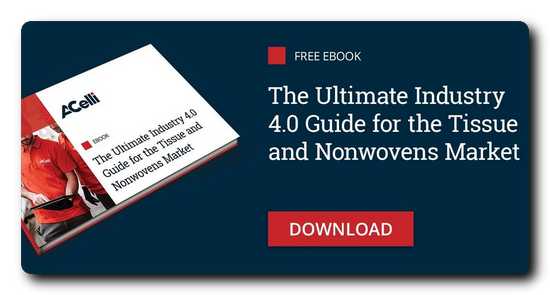In every type of manufacturing, the goal is to produce a superior product as quickly as possible, while producing minimal waste and keeping energy usage to a minimum. The tissue and nonwovens industry is no exception.
Companies in this industry need to produce certain products with specific characteristics on a consistent basis. The processes behind this goal have always been data driven, and for most of the industrial age, those data have come from human observation.
Fortunately, the technological advancements of today make data collection and analysis much easier and more comprehensive, which makes it easier to improve production processes. It is these production processes that define the output of the production line, and whether the final product is successful or there are problems with it, they are the data collected along the production line that hold the answers as to why. Once these data are analyzed, successes can easily be repeated, and failures can be avoided in the future.
Where Data Comes From
The data in a tissues and nonwovens mill come from a myriad of sensors and cameras that are constantly gathering information from each machine during operation. The Industrial Internet of Things (IIoT) makes this possible. The IIoT is a part of Industry 4.0, which has taken computers and automation to a new level, making it easier for humans to interact with and gather and analyze data from machines.
There can be dozens, or even hundreds, of sensors on each machine in the production line. They are all connected to a network, along with other equipment and devices, and they are constantly transmitting data via the cloud in real-time. These data can be stored for future use and/or analyzed and acted on immediately, giving workers insight into what is happening at each stage along the production line.
What Data Reveals
The data that are captured on the production line are analyzed by machine learning programs that have the ability to:
- detect anomalous readings;
- see patterns in the data;
- determine where improvements can be in production processes.
The value of this abundance of data and the insights analysis of the data is significant. For example, if a roll of the highest quality comes off the production line with few or no defects, the data that represent the conditions at each point along the production line reveal the ideal conditions that are required to create the ideal roll. Once these conditions are known, production processes can be adjusted to recreate these conditions in the future.
Read more: How to Measure Tissue and Nonwovens Mill Machinery Performance with Real Time Analytics
The flip side of this scenario is when a flawed roll comes off the line. The data from that run can be analyzed to determine at what point along the production line the conditions caused the flaw. Perhaps the temperature was a little too high or low on one part of the production line, or perhaps the machine speed was a little too high, compromising product quality. Once these data have been analyzed and these insights gained, adjustments can be made in production processes to avoid these flaws in the future.
Thanks to artificial intelligence (AI), full automation along the production line means adjustments to the conditions anywhere along the line can be made in real-time wherever they are needed to improve processes. In short, production processes can be tweaked on an ongoing basis, in real-time, without the need to stop production to make it happen. In addition, the data gathered from the sensors along the production line will reveal problems that require immediate attention and make predictive maintenance possible.
Data Driven Production Process: Integration Is Key
One of the biggest issues for many tissue and nonwovens companies today is that, although they have sophisticated systems that collect data from the production line in real-time, these systems are often siloed from one another. In other words, each machine on the production line will have its own software. This means there is a lack of communication between these systems, making it difficult to integrate the data collected by each machine into an organized whole from which workable insights and solutions can be obtained.
It is the integration of these production line machines with each other and with all other company, supplier, and distribution systems will ensure the best possible data driven production processes can be initiated and maintained. When these systems are tied in with each other and can communicate and share data, production processes can be tailored to the specific needs of the company based on:
- their business and operational goals as an enterprise;
- the availability of the raw materials required for production;
- supply, demand and warehouse stock levels.
The answer to this problem is to use a software platform that is machine- and system-independent. A platform such as this will allow for the easy integration of data from every machine on the production line, ensuring the company can fully embrace data driven production processes. A.Celli’s digital solution offer such a platform.
For more information about data and production processes in your tissue and nonwovens mill, please take a look at our eBook The Ultimate Industry 4.0 Guide for the Tissue and Nonwovens Industry.

